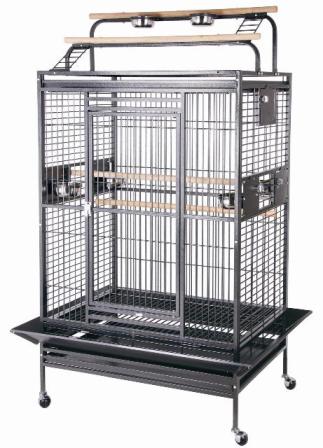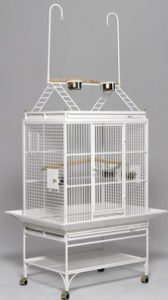Are your birds ready to welcome a new season with a brand new living arrangement? Let’s all MARCH into springtime and talk about cages! Shopping for a new bird cage doesn’t have to be a nightmare. In fact, it can be fun with the right retailer. Bird Cages 4 Less invites you to grab your morning mug, and cozy up with your companion parrot to read our March Cage Series. Throughout the month of March, join us to explore the many options we have to offer for your special feathered friend.
Today, we’re going to address birds which fall somewhere between medium and large and require special considerations. Many popular parrots are included in the category, such as: Timneh and Congo African Greys, all the Amazon parrots, all Eclectus parrots, small cockatoos such as the Goffin, Bare-eyed, Rose-breasted or galah, and Lesser Sulfur Crested, Severe macaws, Red-fronted macaws, Patagonian conures, and the lesser-known Hawk-headed parrot. Any other species which fall in this size category with large beaks, feet, and wingspans should also be included. Appropriate bar spacing for these birds is 3/4, with 1 inch spacing being considered for particularly acrobatic parrots.
As an anecdote, I have kept my Congo African Grey and Double Yellow Amazon in cages with 3/4 bar spacing in the past, and they did very well. They were able to navigate the cage without difficulty, and couldn’t stick their curious heads through the bars. Currently, they are in a cage with 1 inch bar spacing, and have been for approximately two years. They are able to climb and swing with ease even with the larger bar spacing – but there was a learning curve in the first few weeks! They were quite clumsy and took a few extra seconds to scale the walls. Both boys are still safe as their heads don’t fit through the 1 inch space, and I believe they get a little more exercise from climbing.
As mentioned in previous installments of the March Cage Series, some birds in this category have long tails which require special consideration when comparing cage width, depth, and height. Owners of mini-macaws and Patagonian conures will want to select a bird cage with more depth to ensure their birds’ tails remain sleek and undamaged.
While all parrots are highly intelligent and cunning creatures, as you get to larger species, they tend to be even more so. The African Grey parrot is revered for its problem solving skills and quick memory. Bare-eyed cockatoos have been observed using tools to reach food in captivity – an amazing feat! So for our medium-large birds, we must engage their clever minds with a large cage capable of holding thought-intensive foraging toys, multiple perches for play and rest, and just room to stretch their wings.
One such cage is the Lonomea Lookout Double Playtop cage. This cage is a perfectly roomy for your bird, and won’t overta ke the living room, at a size of 36 inches wide by 28 inches deep by 41 inches high inside, with 1 inch bar spacing. While you may want to skip this model for your red-fronted macaw, any other medium-large parrot will enjoy this cage for its lifetime as it has a non-toxic and bird-safe powder coating on the bars. You’ll love this cage because it comes with removable seed catchers, easy-rolling casters, four feeder doors, and a permanent playtop with two levels for double the fun. This cage has the added bonus of an extra breeder door which has a bird-proof latch – just like all the doors on this cage!
ke the living room, at a size of 36 inches wide by 28 inches deep by 41 inches high inside, with 1 inch bar spacing. While you may want to skip this model for your red-fronted macaw, any other medium-large parrot will enjoy this cage for its lifetime as it has a non-toxic and bird-safe powder coating on the bars. You’ll love this cage because it comes with removable seed catchers, easy-rolling casters, four feeder doors, and a permanent playtop with two levels for double the fun. This cage has the added bonus of an extra breeder door which has a bird-proof latch – just like all the doors on this cage!
But, what if you do have a Red-front macaw? Perhaps your Mealy Amazon loves to hang outside down, stretch his wings, and flap like a hurricane? We have you covered – look no further than the Mahalo Manor Double Playtop cage. With a very similar design to the Lonomea Lookout, this cage has all the same perks with the added benefit of being extra large at 40 inches wide by 30 inches deep by 46 inches inside, still with 1 inch bar spacing. You’ll never have to worry about your feathered friend feeling cramped or crowded when you hang toys, hook up an extra perch, or throw a cardboard box at the bottom of the cage for a bird-safe destructible toy. Rest assured that your macaw’s precious tail won’t end up tattered and frayed – this cage is deep enough to allow him to twirl around without grazing the bars!
As we all know, a large cage is no replacement for time spent outside the cage. That’s why the playtop cages are s o great – they combine a playstand and your bird’s safe haven into one. For the parrot whose parront is home to allow for many hours of outside time every day, a slimmer cage is an acceptable choice.
o great – they combine a playstand and your bird’s safe haven into one. For the parrot whose parront is home to allow for many hours of outside time every day, a slimmer cage is an acceptable choice.
One great option is the Avian Adventures Mediana Playop cage. A toy hook on this cage’s permanent playtop makes accessorizing easy; the two food cups and perch make it functional. The cage is a cozy 34 inches wide by 24 inches deep by 33 inches high inside, which makes a toy and an extra perch a possibility. Safety is top priority with this cage with bar spacing at 7/8 inch, which is just a hair above 3/4 inch. Seed catchers and easy-rolling casters make this cage a treat – the storage shelf below keeps it uniquely organized.
With larger species of parrots, using cages with wire bars and plastic bottoms isn’t always a great choice. For one, large parrots tend to be more destructive. Wire bars can be worn down, broken, and snapped by large beaks over time – which is neither cost effective, nor safe! However, for short trips in the car or a visit to the grandparronts, a travel cage is necessary. Check in later this month for a post all about travel cages and travel essentials for all the birds in your family. Better yet, continue to join us here all month long as we continue the March Cage Series for all the birds in your family! You can also visit the large bird tab on our full site to browse all of the cage options available for your medium-large parrot.
2,925 total views, 1 views today
